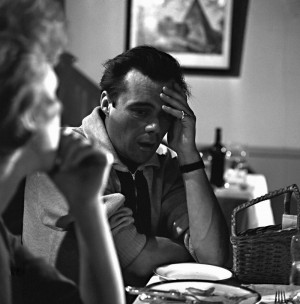At the center of Harold Pinter and Joseph Losey’s “The Servant” (opening Friday at Laemmle’s Royal) is how wonderful—no, how scrumptious—it is to watch James Fox’s sniveling, weakling upper-class gent brought down and subverted by Dirk Bogarde’s all-seeing, smirking house servant.
Pinter’s name precedes Losey’s in the first sentence for a few reasons. One has to do with the film’s distinctly British relishing of the comeuppance of the ruling class (embodied in Fox’s Tony), something the Briton, Pinter, certainly lent the American Losey a greater understanding of in this first of their three inspired collaborations (“The Go-Between” and “Accident” followed) and the most thoroughly realized films Losey directed in the British half of his complex career.
 “The Servant” marked Pinter’s first written (second produced) screenplay, and despite the film’s tepidly received Venice film festival premiere (nearly 50 years ago to the day), it also marked key artistic breakthroughs or turning points for many of its main players: Losey, Pinter, Fox (his first lead), Sarah Miles (as Bogarde’s seductive partner in his perverse domestic arrangement), cinematographer Douglas Slocombe and production designer Richard MacDonald (who conceived the movie’s unforgettable house interior as a circular maze).
“The Servant” marked Pinter’s first written (second produced) screenplay, and despite the film’s tepidly received Venice film festival premiere (nearly 50 years ago to the day), it also marked key artistic breakthroughs or turning points for many of its main players: Losey, Pinter, Fox (his first lead), Sarah Miles (as Bogarde’s seductive partner in his perverse domestic arrangement), cinematographer Douglas Slocombe and production designer Richard MacDonald (who conceived the movie’s unforgettable house interior as a circular maze).
Pinter, however, overshadows all. Fifty years on, Losey’s name is in need of revival (his remake of “M,” set in the old Bunker Hill neighborhood, surpasses Fritz Lang’s original), but Pinter’s is great enough to have long ago been extended to an adjective: Pinteresque.
 Viewed in the light of his plays, with which it shares more than his screenplays for cinema, “The Servant” is one of Pinter’s great comedies of menace (“The Caretaker,” “The Birthday Party”), where an outside intruder disturbs the seeming calm of private lives, and class structures are overturned. Pinter adapted Robin (son of Somerset) Maugham’s novella of the same time, and made it entirely his own. He also appears in a cameo, Hitchcock-style, in an eccentric mid-point restaurant sequence featuring the great, late Patrick Magee, and which Pinter wrote literally overnight during production.
Viewed in the light of his plays, with which it shares more than his screenplays for cinema, “The Servant” is one of Pinter’s great comedies of menace (“The Caretaker,” “The Birthday Party”), where an outside intruder disturbs the seeming calm of private lives, and class structures are overturned. Pinter adapted Robin (son of Somerset) Maugham’s novella of the same time, and made it entirely his own. He also appears in a cameo, Hitchcock-style, in an eccentric mid-point restaurant sequence featuring the great, late Patrick Magee, and which Pinter wrote literally overnight during production.
The restored digital print, handled by revival specialist distributor Rialto Pictures (on a roll this year with stunning revivals of Godard’s “Le petit soldat” and “The Hitchcock 9” package of Hitchcock silent features), gets Slocombe’s black-and-white images as close to a celluloid feel as I’ve seen in any digital restoration to date. 35mm is better, but this is awfully damn close.
Robert Koehler, a film critic for Film Comment, Cinema Scope and Cineaste, blogs about movies on arts·meme.
photo credit: Rialto Pictures


Robin Maugham is Somerset Maugham’s nephew, not his son.